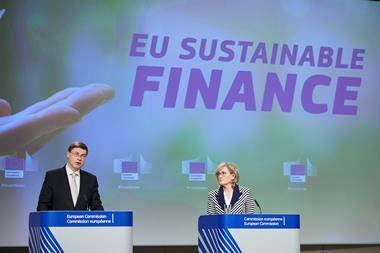The first achievement of the EU’s sustainable finance disclosure regulation (SFDR) has been to provide a clear segmentation of sustainable investing products, according to asset management adviser Indefi.
Under the SFDR, asset managers and other financial market participants have to make different disclosures about different products depending on their ambitions with respect to environmental and/or social considerations.
The disclosure requirements for the two main sets of sustainability-related ambitions are set out in Articles 8 and 9, with the latter seen as the more ambitious category.
In an overview of the open-ended fund market two months after SFDR entered into force, Indefi said asset managers had “adopted the Article 8/Article 9 segmentation as the new language of sustainable investing at a blistering pace”.
It said nearly a quarter of funds domiciled in the EU had been categorised as Article 8 or 9, representing 35% of assets under management (AUM).
The vast majority (31%) are classified as Article 8, which Indefi said it believes will become the baseline for fund selectors and distributors across Europe.
Article 9 products, in turn, “offer the true realm of differentiation for asset managers,” the consultancy said.
Indefi also said that SFDR segmentation highlighted discrepancies across markets, asset classes, and fund management groups.
In terms of AUM by asset class, for example, it found that money market products had the highest share of Article 8 classification (38%), “buoyed by French SRI funds”, while alternatives “justifiably” lagged at below 10%.
In terms of AUM by fund manager size, Indefi’s analysis indicated that Article 8 conversion seemed evenly spread across asset managers, “echoing the widespread penetration of ESG investment methodologies in Europe”.
Article 9 classification, meanwhile, so far seemed the preserve of the largest asset management groups and small focussed impact specialists in the €1-10bn AUM range.
“Clients, both institutional and distributors, are becoming the true regulators of the post-SFDR order”
Asset managers and other financial market participants are currently meeting SFDR requirements without the more detailed implementation rules for certain requirements having become applicable.
SFDR said that discrepancies in product categorisation were likely to fade when the Level 2 rules enter into force next year.
“However, the reality check does not start at classification, but at comparison,” the consultancy wrote. “Clients, both institutional and distributors, are becoming the true regulators of the post-SFDR order.
“As their appetite for sustainable products continues to grow, so will their expectations.”
Sven Gentner, head of the asset management unit at the European Commission, told IPE’s ESG Forum in April that the SFDR was not intended to be a “pure labelling scheme”, but about improving the information given to investors.
Indefi’s analysis covered around 20,000 open-ended funds, including ETFs, for which Morningstar has gathered prospectus-based information on their SFDR classification.



























No comments yet